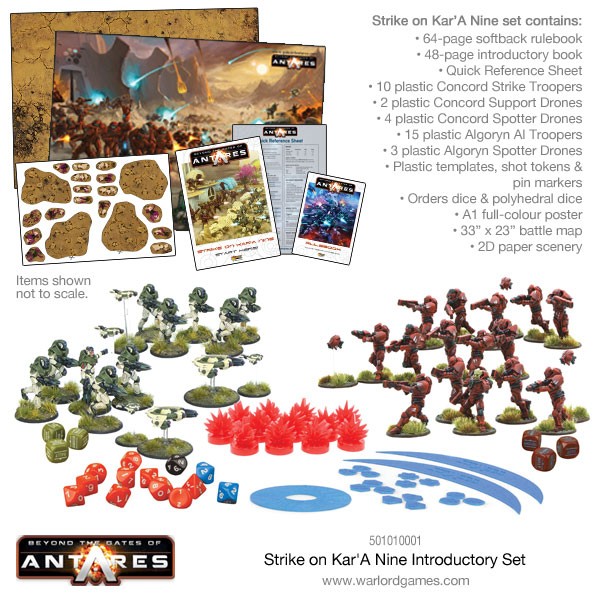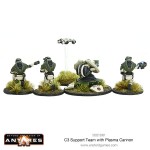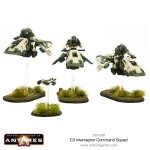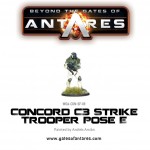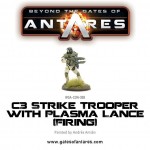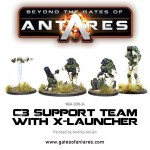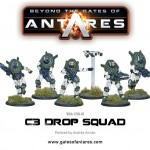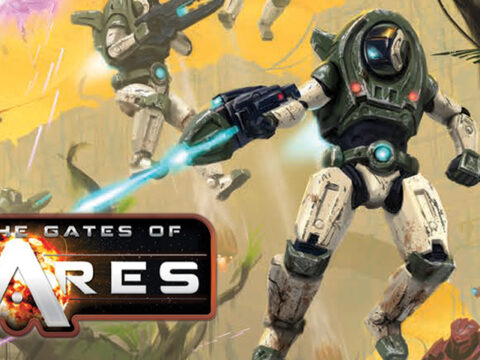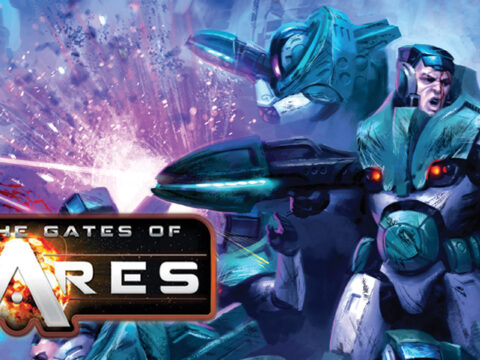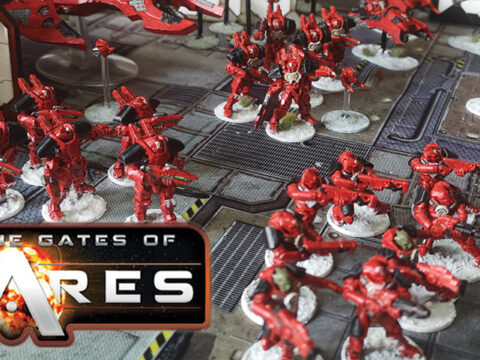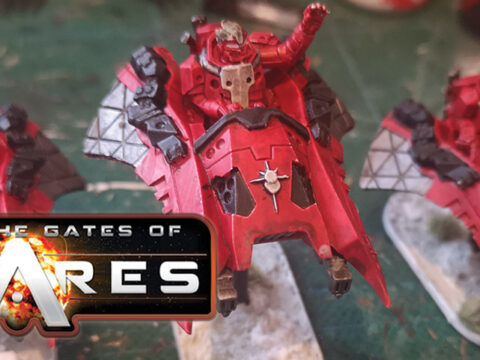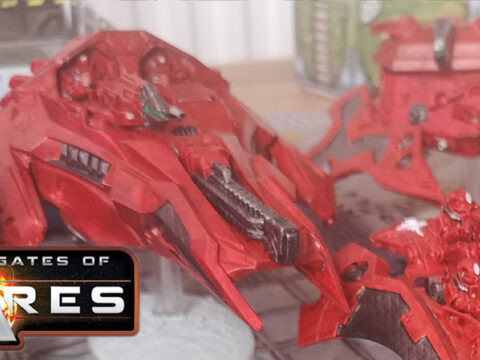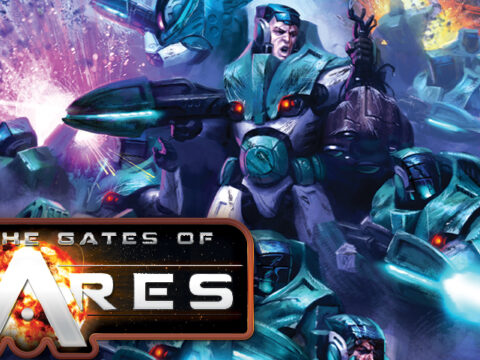Weapons of the Concord Combined Command
By roving UWC reporter Tim Bancroft
Now we’ve signed the Treaty of Confederation with the Panhuman Concord, we’re being allowed closer access to their core technology. I was assigned a trip to a Concord Combined Command (I think it’s called C3) shipboard training school to see at firsthand the weapons with which our armed forces of the United World Convocation will be equipped.
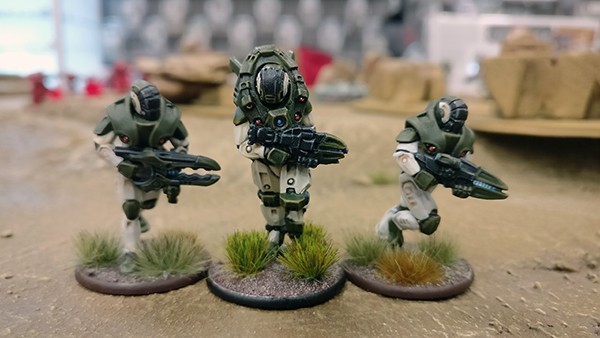
Firstly, it’s strange using one of their ‘transmats’ – what we might call a matter transporter: one minute you’re here, on the planet surface, and the next you’re on board one of their huge, diplomatic cruisers. There’s a little bit of tingling and disassociation, but it’s the sudden appearance elsewhere that’s more disorienting.
Luckily, I was met by an old hand, Teron, as soon as I stumbled off the receiving transmit pad. I asked what rank he was and Teron just smiled, suggesting that the best I could call him in our own language was ‘Sergeant’ as his own rank and role was highly variable. I guess that variability in rank structure will be one of the first things our soldiers will have to adjust to.
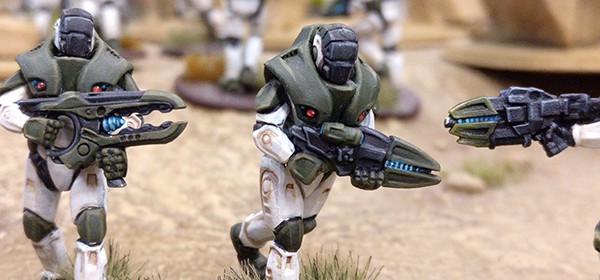
’Sergeant’ Teron was wearing a suit of armour – hyperlight, he called it – with a complex backpack and had, at his belt, a pistol. The armour created something called a hyperlight sink, a protective zone, I suppose, that converted mass to heat or energy or even vice versa, depending on the weapon. It was intelligent, he assured me, adapting itself as necessary but it meant that, close up, the suit was not as effective as against an incoming artillery shell simply because it had less time to react. From this we can infer that ranges, it seems, lay an important role in the design of C3 battlefield tactics.
Hyperlight armour: +1 Res bonus at less than 10”, +2Res bonus at ranges greater than 10”, +3 Res bonus vs blast.
I asked him about his pistol and he offered to take me straight to the onboard range. How could I refuse! He simply stepped onto the transmit pad, urged me up beside him and requested the closest, empty, live-fire practice range. Instantly, we were inside a 500 metre long shooting range (he told me it was 100 yan, which gives us some idea of their measurement system).
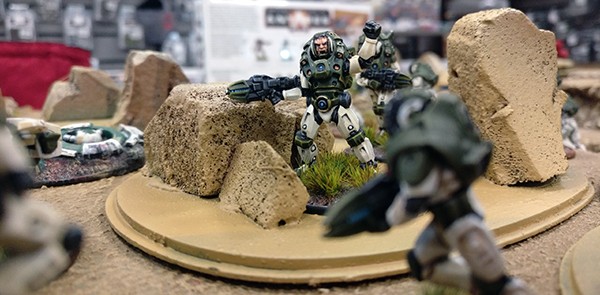
First off, he gave me his pistol. ‘Try it,’ he said. It was fairly large, but lighter than I expected. ‘It’s a plasma pistol,’ he explained. ‘That’s the trigger: shoot.’
I examined the pistol: it had a series of glowing, spiral or solid coil at the business end, what looked like a tiny power pack behind that and a standard handstock at the rear – much like our own handguns. There was something missing: a safety. When I asked Teron about it, he looked puzzled: ‘It’s safe,’ he said.
‘Can I make it active, I meant?’
He nodded. ‘Sure. It’s active,’ he said, so I trained it on a target I could barely see and depressed the simple trigger.
Nothing happened and I handed it back to him. ‘It’s not working.’
He smiled, shook his head and a visor quickly extruded itself from his armour, flipping down over his face. Without apparently doing anything to the pistol, he casually aimed it down range and pressed the trigger. A beam of light or hot air could be seen and the closest target vaporised in a small cloud of roiling plasma.
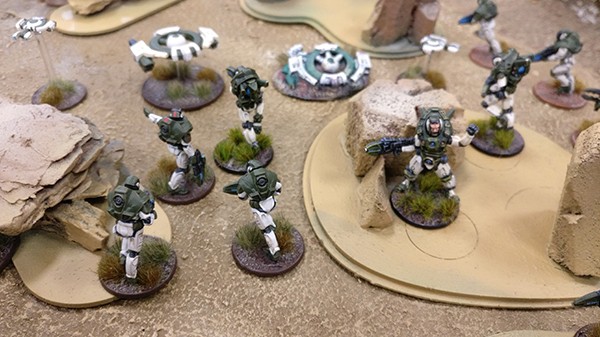
Yes, I jumped. He then he explained why he could make it work and I couldn’t. Apparently all the C3 weapons are intelligent, completely integrated with their nanosphere and making substantial use of localised nanospore to identify who can shoot them, to maintain themselves (within reason) and for power. His plasma pistol was attuned to him and his combat shard (a squad, it seemed, though I am hazy about his rather flexible use of the word ‘shard’) and wouldn’t allow itself to be used by a non-Concord user, even another human like myself. It even uses technology to project it’s aiming point on whatever combat display its authorised user was wearing. This combat display is most often an integrated helmet but could just as likely be combat lenses or even optical implants (the latter are something I’d struggle with, I think).
Teron gave me a practice helmet so I could see for myself. First off, even with the helmet all I could see were words transcribed across a display, the words quickly changing to our own language: unauthorised user. The armour and pistol themselves would not let me operate them! Teron explained that he would have to give me temporary authority, limited to the range itself, and even then it wouldn’t allow me to aim at a human or drone other than a practice, target drone. ‘We take personal wellbeing very seriously in the C3,’ explained Teron. ‘We are exposed to enough disharmonious situations as it is.’
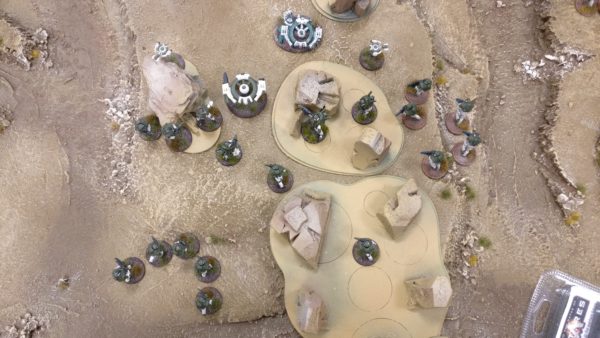
Disharmonious situations? I presumed he meant battlefields or conflict zones, but was unable to confirm the assumption as Teron had quickly given me the relevant authorisation. Teron then took me through all the weaponry the Concord troops were likely to use, from the pistol he carried upwards.
Firstly, all the infantry weapons display their targeting and combat information on the combat display: you can state what sort of cross-hairs or targeting shape you want and it appears on the display where the gun is aimed! Things can get more complicated, explained Teron, such that handheld displays or additional, optical magnification was required, but the majority of the shard’s and weapon’s information was available on the combat display.
The plasma pistol is a powerful little beast. For comparison, Teron had the ship materialise a replica of our own combat armour down-range and asked me to shoot it. Whilst it was tricky aiming the plasma pistol at longer ranges, just like our own revolvers and semi’s, it packed a horrific punch, vaporising the armour’s chest plate with little problem. ‘It causes a level two vaporisation,’ explained Teron. He anticipated my next question: ‘And we go up to level seven or so with field weapons like the plasma bombard, more with shipboard weaponry.’
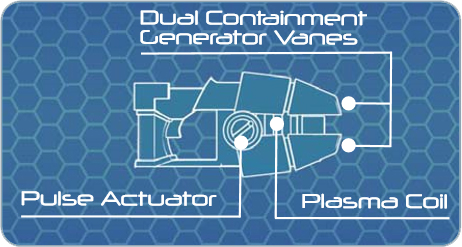
| Range | ||||
| Weapon | Effective | Long | Extreme | Strike Value |
| Plasma Pistol | 10 | 20 | 30 | 2 |
I asked about grenades and was shown and ordinary (though small) grenade. ‘A plasma grenade,’ explained Teron. ‘Causes a localised ionisation, about level one.’
| Range | ||||
| Weapon | Effective | Long | Extreme | Strike Value |
| Plasma Grenade | 5 | None | None | 1 |
I gave the grenade back to him, gingerly, but Teron hadn’t finished. He surprised me by showing a device strapped to his forearm, a micro-grenade launcher running on electro-pulse principles, a sort of miniaturised railgun. He explained the C3 tend to use two different types of ammunition, an explosive and slingnet – whatever that meant. ‘This is an X-sling,’ explained Teron, ‘and it can fire a net round – hence slingnet.’
I was none the wiser. ‘I can show you,’ he said, and spoke to mid-air in a clipped, rapidly varying language. I heard no reply, but he nodded and, when he saw my face, explained: ‘I’m speaking to the ship. It’s using focused acoustics to reply directly to me. I’m arranging medic cover, as I think the best way I can show you how net works is for you to experience it yourself.
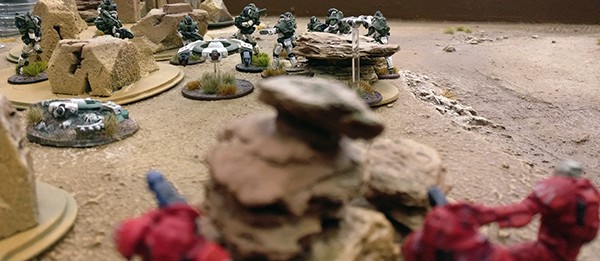
I choked, and he explained. I was to be fitted with a suit of hyperlight and this slingnet would be fired at me. ‘You’ll be safe,’ he said. ‘The ship will make sure.’ He went on to explain the slingnet round would generate a suppression field that would push me to the ground, but not, otherwise, hurt me other than if I resisted too hard, when it might break a bone! As long as the medi-drone was nearby (an odd, floating drone with dangling manipulators), I’d be fine.
Whilst I was being fitted, Teron showed me the X-sling’s micro-grenades. They did not cause as much damage against the armour, but certainly had a shorter range. Trouble is, the explosive radius was as much as any other grenade so, understandably, I was nervous as I walked down-range to have the slingnet microgrenade fired at me.
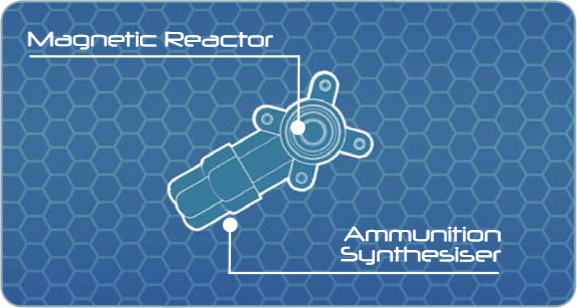
| Range | ||||
| Weapon | Effective | Long | Extreme | Strike Value |
| X-Sling | 10 | 20 | None | 2 |
Special Rules
Blast D3, Special Munitions
The clarity of audio-visual reception in the C3’s armoured suits is superb. I could hear Teron – and see a video of his face – as if he was right beside me. It was also quite cool, as if air-conditioned. After I walked about 30 paces down-range, Teron told me to stop. I turned, and he then fired his micro-grenades. I flinched, but the blast flared into light around me and I was totally unharmed. And I mean completely unharmed, as if nothing had happened.
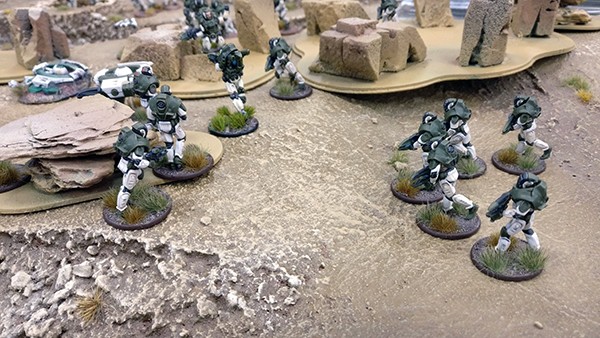
‘Firing net,’ said Teron over the suit’s comm. He raised his arm again, and a small grenade shot from his X-sling. This time, it felt as if I was being trampled on by an elephant. I staggered back and was forced to my knees under an unbearable pressure. It took a while to die down, during which time I struggled to move my arms and legs. All the time, though, Teron was monitoring my health through the suit – on my display, I could even see him and the medi-drone asking the suit for details on my blood pressure, heart rate, respiration, CO2 expiration.
Despite that, don’t ask someone to fire slingnet at me again.
We then moved up to the bigger weapons, Teron obviously proud of his equipment. ‘Take a look,’ he said, hefting an odd-looking weapon the length of one of our own carbines, ‘This is our basic plasma carbine, one of the premier weapons throughout Antarean space.’ It had a coil, like the pistol, and a bigger actuator and he showed me how what we’d call it’s power pack or ammunition was fitted. Teron explained it had two modes, which were translated as ‘Single Shot’ and ‘Scatter’ – I guessed semi-automatic and fully automatic. ‘Try it,’ he said.
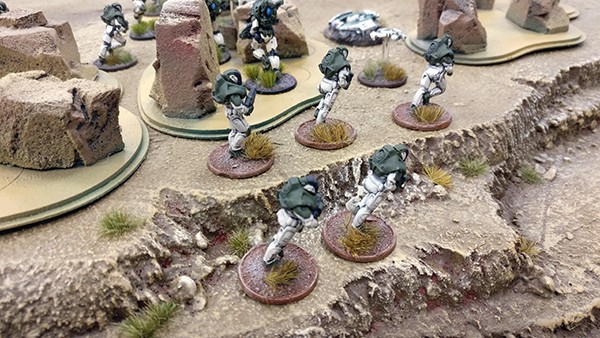
This time, the armour was moved way down the range – the plasma carbine has a much longer range than the pistol. It was still level two (so my suit display, said: I love that suit display!) and proved as effective in vaporising our armour as the pistol. When switch to ‘scatter’ mode, though, the ionisation focus allowed for multiple, rapid shots, much like a machine gun. ‘It’s less effective than single shot,’ said Sergeant Teron, ‘so we tend to use it against lighter armed opponents but the single shot is best for Ghar.’
I had no idea who or what he meant by the Ghar.
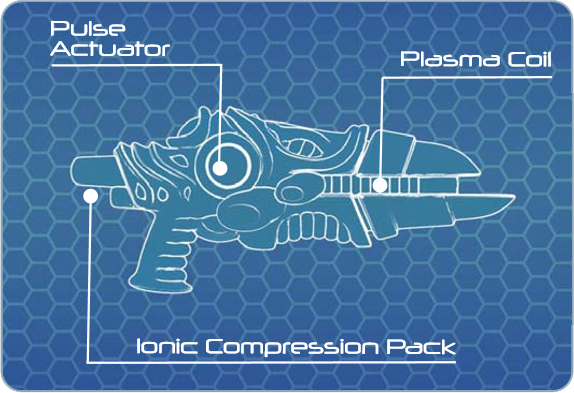
Restricted priority Delta: Captured Senetex pattern plasma carbine
| Range | ||||
| Weapon | Effective | Long | Extreme | Strike Value |
| Plasma Carbine | 20 | 30 | 50 | 2 |
He muttered to the room and more targets appeared, then opened a panel and pulled out another weapon. This was similar to the carbine but larger, as if it were the jaws of a beetle set on edge. It was bulky and seemed awkward to heft, but once more there was the strange coil at the middle. ‘Another plasma weapon?’ I asked. He nodded, aimed it down-range and let loose. This time the ionisation trail was a solid line through the air and when it struck a target, the explosion rocked the room.
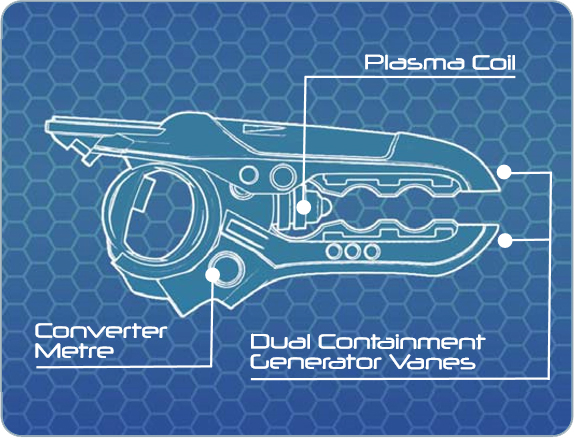
| Range | ||||
| Weapon | Effective | Long | Extreme | Strike Value |
| Plasma Lance | 20 | 30 | 50 | 4 |
Special Rules
Choose Target, Inaccurate
‘Level four,’ said Teron. ‘Good against light vehicles, but unwieldy. We normally have to uses a spotter.’ I nodded though, in truth, I had no idea what a spotter was. Later I was to discover that a ‘spotter’ is a type of drone that accompanies a squad in the field to enhance targeting.
‘Are any of your weapons non-plasma?’ I asked. Teron pointed to his X-sling. ‘Other than that, I mean?’ I was told to wait as, one by one, additional weapons materialised along the head of each shooting lanes.
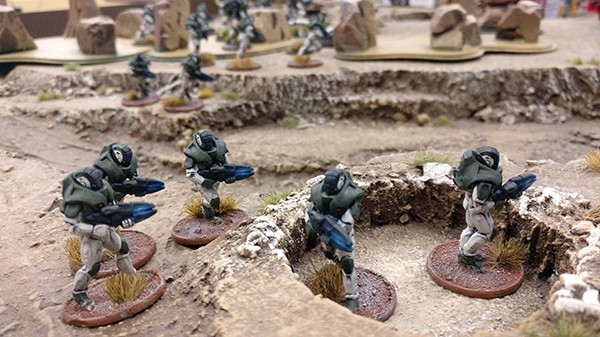
The first looked like an enlarged plasma carbine, but looked as if it had been detached from a side-mount. I took a guess: ‘Squad support?’ Encouraged, I hazarded a second guess. ‘From a strike fighter?’ Teron explained that it was a rapid fire version of the plasma weaponry, firing level three bursts, but was normally attached to a drone about the size of a man. He slapped his hands on the weapon next to it – an even larger version – and explained it was a plasma cannon, a level six device. I declined a demonstration, having been shocked enough at the level four lance, but could well believe it was capable of seriously damaging one of the heavy tanks the Concord claimed they sometimes had to face.
Teron seemed quite relieved I didn’t ask for a demonstration. ‘It’s powerful,’ he explained, ‘but sometimes the coils can overheat and you have to spend a few seconds resetting the thing. There’s a bigger version, the level seven bombard, but it suffers from the same overheating. And the trouble is, with the Senatex, almost anything can happen – especially with their creepy Tsan Ra’. I asked what ‘Tsan Ra’ were, and he showed me images of some horrific-looking, six-limbed creatures carrying heavy, organic-looking versions of plasma carbines. He saw my disgust. ‘Yep, that’s what the Senatex allies itself with. Pretty bad, eh?’ He slapped the light support weapon. ‘But this is an effective counter.’
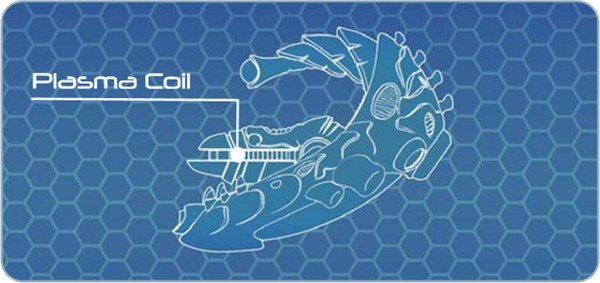
Restricted priority Delta: Captured Senetex pattern plasma equiped drone
| Range | ||||
| Weapon | Effective | Long | Extreme | Strike Value |
| Plasma Light Support | 30 | 40 | 80 | 3 |
Special Rules
RF3
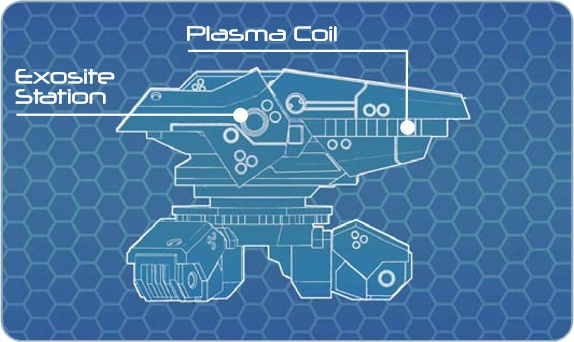
| Range | ||||
| Weapon | Effective | Long | Extreme | Strike Value |
| Plasma Cannon | 30 | 40 | 80 | 6 |
Special Rules
Plasma Fade
We skirted over the heavier weapons, mostly vehicle mounted: a plasma bombard, a larger version of the plasma cannon; a fractal dissonance cannon for disintegrating the molecular binding on stationary objects such as buildings; a compression weapon that uses their storage technology to compress an item – or parts of a target – in both cannon and bombard (heavy) form. Teron also mentioned some mortar, hi-trajectory weapons that used the same mag-rail launch technology as his X-sling, but on a much larger scale.
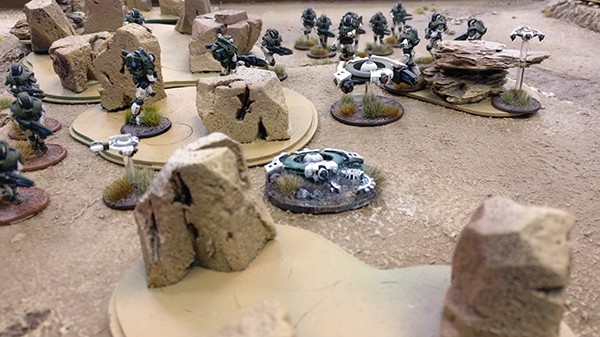
‘And with those,’ he said, ‘You can get some interesting ammunition too. You’d call it grip, scoot, scrambler… and more net. All sorts. Useful stuff in the right circumstances.’
We were running out of time, so I left questions about such specialised ammunition for later. Instead, I asked about the staves we’d seen carried by their elegant Mandarins and, for the first time, Teron was evasive. ‘That’s an example of full integration with the nanosphere, complete harmony. The NuHu can exert an influence over the nanospore we just cannot comprehend.’ He shook his head. ‘Short range, but highly effective.’ There, we had to break and his change of mood at the mention of the NuHu Mandarins seemed a good time to stop.
For us, there is much to learn about the Concord and their attitude to the battlefield – or ‘disharmonious situation’ as Teron called it. Given the effectiveness of their weaponry and armour, it looks like we made the right choice. Interactions with the PanHuman Concord all give the same impression: despite their military capability, the Concord are all about harmony.
That, I suspect, is the biggest lesson our planet can learn.
Do you have an article within you? Are you itching to show your collection to the world? Join our Beyond the gates of Antares facebook page for the most up to date news and more!
Concord in Gates of Antares!
